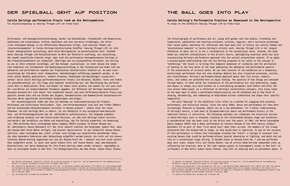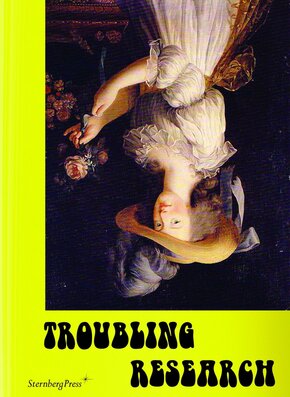BOOKS
“One is not given space, one occupies it.”
Carola Dertnig’s (b. Innsbruck, 1963; lives and works in Vienna) oeuvre encompasses drawings, collages, and photographs as well as live performances in public settings. Her performative art is informed by her probing studies of movement as a language and the history and theory of performance. In pieces like Tanzporträt Harald Kreutzberg (2014) or Lora Sana (2005), a feminist history of Viennese Actionism, she devises novel forms of historiography that stake out a new place in the present for performers who may have been forgotten. Based on numerous interviews with women who were part of Viennese Actionism in the 1960s and 1970s, she develops the fictional Actionist Lora Sana to champion a revision of this largely male-dominated terrain in a female perspective.
The publication Dancing Through Life presents a comprehensive survey of Carola Dertnig’s oeuvre from 1997 to 2024. The book documents the solo exhibition of one of Austria’s leading performance artists at OK Linz by retracing her artistic research into the history and theory of performance art. With an essay by Freda Fiala, an introduction by Michaela Seiser, and a conversation between Barbara Clausen and the artist.
https://www.distanz.de/en/carola-dertnig/dancing-through-life
https://www.thalia.de/shop/home/artikeldetails/A1072573101
https://www.ooekultur.at/detail/carola-dertnigdancing-through-life
Carola Dertnig. donauspuren digital wideness and other things
Christian Bauer (ed.) State Gallery of Lower Austria
Texts by Christian Bauer, Carola Dertnig, Carola Platzek, Amelie Bachfischer
German / English, 112 pages, 21 × 25.5 cm, numerous illustrations in color, softcover
January 2020
ISBN 978-3-903172-52-4
In her works (installations, videos, and performances), Carola Dertnig is interested in artistic processes—in terms of historiography, genres, and perspectives. The artist develops structures for missing histories and invents people or entire settings intervening in the past.
This catalogue documents performances and objects in the exhibition Danube Traces at the State Gallery of Lower Austria (Oct. 19, 2019–May 24, 2020), in which archeological excavations conducted during the construction of the new State Gallery building play a crucial role. Medieval and Roman finds and generational transitions permeate each other to make viewers think: What does the past’s infiltration of the present mean—is it enough of an impulse to grasp the present as an implementation of the past? How clear-cut are historical shifts? What consequences do constructions have on living spaces and scopes of action, how do they change paths and routes, what is the relationship between city and countryside? Hopping from one generation and place, one memory and experience to the next, Dertnig interrelates such histories, making them visible from many angles.
Contributions by Philip Auslander, Sabeth Buchmann, Margarit von Büren, Barbara Clausen, Carola Dertnig, Andrea Fraser, Sabine Gebhardt Fink, Simone Forti, Sabina Holzer, Amelia Jones, Carrie Lambert-Beatty, Marie-Luise Lange, Suzana Milevska, Lilo Nein, Susanne Neuburger, Yvonne Rainer, Constanze Ruhm, Dietmar Schwärzler, Stefanie Seibold, Felicitas Thun-Hohenstein, Mechtild Widrich, Martha Wilson --------------- ''Performing the Sentence'' brings into dialogue the ways that ''performative thinking'' has developed in different national and institutional contexts, within different disciplines in the arts, and the conditions under which it has developed in experimental art schools. This anthology is a collection of twenty-one essays and conversations that weave in and out of the two key areas of research and teaching within performative fine art. They bring to light the conventions involved in the production, presentation, reception, and historicization of performance art, as well as the specific cultural and political implications. The various contributions also show how these conventions are produced through or within each artwork, independent from their specific contexts, offering ways of thinking beyond their usual frames of reference. At the same time they recognize the substantial work carried out by artists, critics, and theorists who have built on the meanings, references, and implications of performative thinking since the beginning of the ''performative turn.''
Edited and with contributions by Carola Dertnig, Diedrich Diederichsen, Tom Holert, Johannes Porsch, Johanna Schaffer, Stefanie Seibold, and Axel Stockburger.
In 2010/11, a group of Vienna-based art practitioners (artists, art historians, and cultural theorists) embarked on a journey of experimental research, exploring the genealogical and political implications of the ways in which research rhetorics and policies are currently incorporated into the fields of contemporary art and art education. Troubling Research: Performing Knowledge in the Arts, a collection of “books” of essays and conversations, is the quirky and exhilarating outcome of this collaborative endeavor to render a “problematization” by interrogating the very conditions of the current upsurge of the art/research articulation.
Michel Foucault once introduced problematization as a “specific work of thought” that transforms “a group of obstacles and difficulties into problems to which diverse solutions will attempt to produce a response.” For this project, the obstacles and difficulties in question were the terms “art” and “research” and their peculiar conjunction as “artistic” or “arts-based research.” As a result of this process, the understanding of individual artistic/theoretical practices was tested. Working both independently and as a collaborative entity, the group found itself negotiating and contesting each participant’s claim to knowledge in the context of art. The eventual responses to the problem of research proved to be both performative and troubling.
Historical and contemporary objects of performance are documented in this wide-ranging anthology, the first to chart the historical development of the medium in Austria. The volume published by Carola Dertnig and Stefanie Seibold shows a vast array of pieces from the past four decades. It also offers public access to a number of artistic items for the first time: items which, despite having been – and remaining – central to the domestic art scene, have been overlooked in official accounts of art history. The volume consciously highlights productions rooted firmly in an artistic context, and also establishes connections to experimental performance-related productions from theatre and revue as well as links to creative political activism. There is a specific emphasis on works dealing with sex and gender, subject matter that has generally been explored through the performance medium since the 1970s.
This richly illustrated and bilingual publication thereby raises awareness of the history of a medium which has consistently delivered critical impetus over recent decades, revolutionising the self-image of contemporary art and its reception. Several pages of text and images are dedicated to each of around fifty objects. Interviews with those who were there at the time, expert comment and in-depth analyses elucidate the relevance of the medium to present-day art, interpret the more stimulating approaches and strategies currently applied and reveal interconnections with other spheres of art.
REVIEW
Artpulse Magazine















